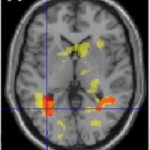Literacy Re-wires the Brain
 In a study published today in Science, functional magnetic resonance imaging (fMRI) was used to study the brains of 63 adults: 10 were illiterate, 22 learned to read as adults, and 31 learned to read as children. Brain responses to spoken and written language, visual faces, houses, tools, and checkers were examined.
In a study published today in Science, functional magnetic resonance imaging (fMRI) was used to study the brains of 63 adults: 10 were illiterate, 22 learned to read as adults, and 31 learned to read as children. Brain responses to spoken and written language, visual faces, houses, tools, and checkers were examined.
The main differences found between literate and illiterate brains were:
1- The brains of all literate adults showed more vigorous responses to written words. This occurred in brain regions known to process visual information.
2- The brains of all literate adults also showed enhanced activity in left-temporal areas known to respond to spoken language.
2- The brain of illiterate adults showed enhanced activity in the left occipital-temporal region of the brain known to respond to faces.
.
What does it mean?
These results suggest that learning to read changes the brain, not surprisingly, in the regions involved in vision and written language and, more surprisingly, in regions involved in oral language as well. These changes may happen at some cost: The brains of literate adults showed less response to faces than the brains of illiterate adults. This may come from the fact that literate brains have to share regions of the occipital-temporal cortex between words and faces. Whether this translates into real behavioral differences is not know so far.
Interestingly, the changes happened in the brain whether adults learned to read as children or much later. This is a great example of neuroplasticity: Learning can change the brain, at all ages.
Related article: Brain Plasticity: How learning changes your brain



Awesome. Personally, I’d say that the literate brain is, aside from nutritional considerations, more fit and healthy than the illiterate brain — but it’s not like I can run up and down the street shouting it, because I haven’t read of any studies showing that the literate brain has greater volume than the illiterate brain. Anybody out there seen anything on the matter?